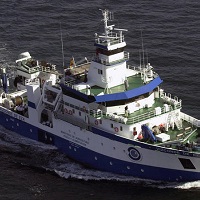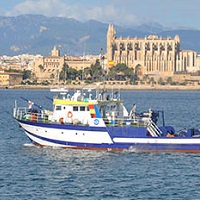Keyword
Fish-finder echosounders
93 record(s)
Type of resources
Categories
Topics
INSPIRE themes
Keywords
Contact for the resource
Provided by
Years
Formats
Status
-

Study and evaluation of the biomass of the anchovy in the Bay of Biscay within the National Sampling Plan.
-

Study and evaluation of the biomass of the anchovy in the Bay of Biscay within the National Sampling Plan.
-

Study and evaluation of the biomass of the anchovy in the Bay of Biscay within the National Sampling Plan.
-

1.Estimar índices de abundancia de reclutas y juveniles de langosta. 2.Determinar la estructura demográfica y distribución batimétrica de los juveniles. 3.Estimar la abundancia y demografía de la langosta mediante técnicas de video sumergido con cebo. 4.Evaluar el efecto de la ampliación de la reserva marina mediante video sumergido y censos visuales. 5.Obtener muestras de ejemplares recién asentados talla inferior a 15 mm LC (Longitud de Cefalotórax) para estudios de genética de poblaciones y composición isotópica.
-

1) Recogida de los datos necesarios para estimar los índices de abundancia y biomasa de las especies de interés comercial, listadas a continuación: - bacalao (Gadus morhua) - gallinetas (Sebastes spp) - platija (Hippoglossoides platessoides) - fletán negro (Reinhardtius hippoglossoides) - limanda (Limanda ferruginea) - granadero (Macrourus berglax) - raya (Amblyraja radiata) - mendo (Glyptocephalus cynoglossus) - tiburón negro (Centroscyllium fabricii) - bertorella tenuis (Urophycis tenuis) - camarón (Pandalus borealis) 2) Muestreo de contenidos estomacales (frecuencia bienal - años pares) 3) Recogida de datos hidrográficos con una batisonda 4) Identificación de organismos invertebrados
-
Campaña: 3LNO GROUNDFISH SURVEY (FLETAN NEGRO 3L 2015) 3LNO GROUNDFISH SURVEY (FLETAN NEGRO 3L 2015)

The surveys on NAFO Regulatory Area of Div. 3L (Flemish Pass) were initiated by Spain in 2003. The surveys were carried out by the R/V “Vizconde de Eza” following the same procedures and using the same bottom trawl net type Campelen. The main objectives of this survey time series are: a) to obtain abundance indices of the main exploited species, b) to study the structure and distribution of these demersal species in the area.
-

El objetivo de la campaña es conocer el estado de las poblaciones de las especies objetivo: su abundancia, biomasa y estructura demográfica, y las condiciones oceanográficas en el Banco. Este objetivo implica las siguientes acciones: • Prospectar el área de Flemish Cap, División 3M de NAFO hasta profundidades de 1460 m (800 brazas) mediante un muestreo aleatorio estratificado, haciendo 181 pescas1 de arrastre con un arte Lofoten, diurnas: entre las 6.00 y las 22.00 horas, y una duración efectiva de arrastre de 30 minutos. • Realizar en cada pesca un muestreo biológico detallado de la captura para cada una de las especies objetivo, que incluya muestreos de talla, sexo, peso, otolitos y gónadas. Para las demás especies sólo se hará muestreo de tallas y muestreos talla-peso. • Análisis de los contenidos estomacales de las principales especies capturadas, a realizar cada dos años2. • Identificación y registro de todas las especies de invertebrados presentes en las capturas. • Registrar las condiciones oceanográficas en el banco haciendo estaciones de CTD para cubrir un retículo con 15 millas de separación, tanto en longitud como en latitud. • Colaborar en las tareas llevadas a cabo a bordo, para el proyecto iSeas, que pretende mediante la monitorización de imágenes la cuantificación de las capturas de las especies más importantes.
-
Campaña: 3LNO GROUNDFISH SURVEY (FLETAN NEGRO 3L 2019) 3LNO GROUNDFISH SURVEY (FLETAN NEGRO 3L 2019)

The surveys on NAFO Regulatory Area of Div. 3L (Flemish Pass) were initiated by Spain in 2003. The surveys were carried out by the R/V “Vizconde de Eza” following the same procedures and using the same bottom trawl net type Campelen. The main objectives of this survey time series are: a) to obtain abundance indices of the main exploited species, b) to study the structure and distribution of these demersal species in the area.
-

Spanish Porcupine bottom trawl survey aims to collect data on the distribution and relative abundance, and biological information of commercial fish in Porcupine bank area (ICES Division 7b-k). The primary target species are hake, monkfish, white anglerfish and megrim, which abundance indices are estimated by age, with abundance indices also estimated for Nephrops, four-spot megrim and blue whiting. Data collection is also collected for several other demersal fish species and invertebrates.
-
Campaña: 3LNO GROUNDFISH SURVEY (FLETAN NEGRO 3L 2016) 3LNO GROUNDFISH SURVEY (FLETAN NEGRO 3L 2016)

The surveys on NAFO Regulatory Area of Div. 3L (Flemish Pass) were initiated by Spain in 2003. The surveys were carried out by the R/V “Vizconde de Eza” following the same procedures and using the same bottom trawl net type Campelen. The main objectives of this survey time series are: a) to obtain abundance indices of the main exploited species, b) to study the structure and distribution of these demersal species in the area.
 Catálogo de datos del IEO
Catálogo de datos del IEO